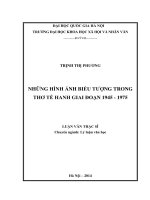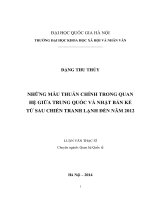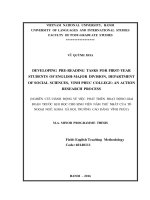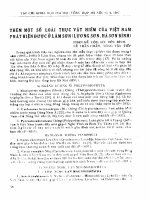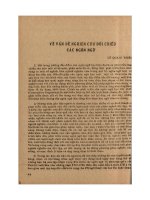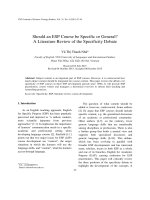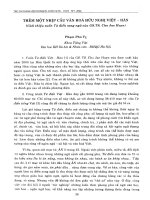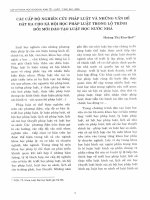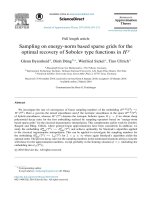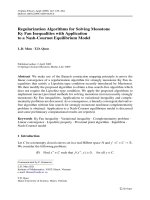DSpace at VNU: Thêm vào Góc nghiên cứu Developing pre-reading tasks with first-year students of English-major Division, Department of Social Science, Vinh Phuc College: An action research
Bạn đang xem bản rút gọn của tài liệu. Xem và tải ngay bản đầy đủ của tài liệu tại đây (449.98 KB, 24 trang )
VIETNAM NATIONAL UNIVERSITY, HANOI
UNIVERSITY OF LANGUAGES AND INTERNATIONAL STUDIES
FACULTY OF POST-GRADUATE STUDIES
*****************
VŨ QUỲNH HOA
DEVELOPING PRE-READING TASKS FOR FIRST-YEAR
STUDENTS OF ENGLISH-MAJOR DIVISION, DEPARTMENT
OF SOCIAL SCIENCES, VINH PHUC COLLEGE: AN ACTION
RESEARCH PROCESS
(NGHIÊN CỨU HÀNH ĐỘNG VỀ VIỆC PHÁT TRIỂN HOẠT ĐỘNG GIAI
ĐOẠN TRƯỚC KHI ĐỌC CHO SINH VIÊN NĂM THỨ NHẤT CỦA TỔ
NGOẠI NGỮ, KHOA XÃ HỘI, TRƯỜNG CAO ĐẲNG VĨNH PHÚC)
M.A. MINOR PROGRAMME THESIS
Field: English Teaching Methodology
Code: 60140111
HANOI – 2016
VIETNAM NATIONAL UNIVERSITY, HANOI
UNIVERSITY OF LANGUAGES AND INTERNATIONAL STUDIES
FACULTY OF POST-GRADUATE STUDIES
*****************
VŨ QUỲNH HOA
DEVELOPING PRE-READING TASKS FOR FIRST-YEAR
STUDENTS OF ENGLISH-MAJOR DIVISION, DEPARTMENT
OF SOCIAL SCIENCES, VINH PHUC COLLEGE: AN ACTION
RESEARCH PROCESS
(NGHIÊN CỨU HÀNH ĐỘNG VỀ VIỆC PHÁT TRIỂN HOẠT ĐỘNG GIAI
ĐOẠN TRƯỚC KHI ĐỌC CHO SINH VIÊN NĂM THỨ NHẤT CỦA TỔ
NGOẠI NGỮ, KHOA XÃ HỘI, TRƯỜNG CAO ĐẲNG VĨNH PHÚC)
M.A. MINOR PROGRAMME THESIS
Field: English Teaching Methodology
Code: 60140111
Supervisor: Dr. Vũ Thị Thanh Nhã
HANOI – 2016
DECLARATION
I certify that the work contained in this thesis is the result of my own research, and
this thesis has not been submitted for any degree at any other university or
institution.
Hanoi, January 2016
Signature
Vũ Quỳnh Hoa
i
ACKNOWLEDGEMENTS
I am indeed thankful to my supervisor, Dr. Vũ Thị Thanh Nhã, whose
sympathetic guidance has been the source of inspiration and knowledge for my
research. I am also grateful to other teachers of the Department of Post-Graduate
Studies for their encouragement and valuable advice.
I have profound regards for all the teachers of English-major Division of
Vinh Phuc College and for all of the English-major freshmen of the class 18 who
spent their precious time on completing my survey questionnaire. Without their
enthusiastic cooperation, my thesis would not have been completed.
My great thanks are also given to my family and my friends who have
constantly supported, inspirited and encouraged me during the process of my study.
ii
ABSTRACT
This action research focused on finding out the primary problem related to
using pre-reading tasks; hence, the major purpose of the study aimed to develop
pre-reading tasks for improving students’ reading performance. The research was
conducted with first-year students of English-major Division, Department of Social
Science, Vinh Phuc College. Data were collected through 4 observed lessons and
two sets of survey questionnaire delivered to 32 freshmen of the class 18 English
after the lessons. The research findings revealed the problem of ineffective use of
pre-reading tasks in reading lessons as well as its causes and effects on students’
reading performance. Finally, I also presented suggestions for developing prereading tasks that the teachers have used in their reading lessons for improving
students’ reading performance.
iii
LIST OF ABBREVIATIONS
AR: Action Research
No: Number of students
Ss: Students
iv
LISTS OF FIGURES AND TABLES
Figure 1: Action research procedure
Figure 2: Simple action research model (Kemmis & McTaggart, 2008, p.278)
Figure 3: Detailed Action Research Model (Susman, 1983)
Table 1: Students’ assessment on the first lesson
Table 2: Students’ assessment on pre-reading tasks used in the first lesson
Table 3: Reasons for effectiveness and ineffectiveness of pre-reading tasks
provided by the students
Table 4: Students’ assessment on exercises and tasks at the while and post reading
stages in the first lesson
Table 5: Students’ suggestions about efficient pre-reading tasks in the next reading
lesson
Table 6: Students’ assessment on the first try-out lesson
Table 7: Students’ assessment on pre-reading tasks used in the first try-out lesson
Table 8: Reasons for effectiveness of pre-reading tasks provided by the students
Table 9: Students’ assessment on exercises and tasks at the while and post- reading
stages in the first try-out lesson
v
TABLE OF CONTENTS
DECLARATION ....................................................................................... i
ACKNOWLEDGEMENTS ...................................................................... ii
ABSTRACT............................................................................................. iii
LIST OF ABBREVIATIONS .................................................................. iv
LISTS OF FIGURES AND TABLES ....................................................... v
TABLE OF CONTENTS ......................................................................... vi
CHAPTER 1: INTRODUCTION .............................................................. I
1.1. Rationale ..................................................................................................................I
1.2. Aims of the Study ................................................................................................. II
1.3. Research questions ............................................................................................... II
1.4. Significance of the Study .................................................................................... II
1.5. Scope of the Study ................................................................................................ II
1. 6. Method of the research ..................................................................................... III
1. 7. Design of the study ............................................................................................. III
CHAPTER 2: THEORETICAL BACKGROUND...................................V
2.1. Introduction........................................................................................................... V
2.2. Theoretical background of reading.................................................................. V
2.2.1. Definitions of reading .............................................................. V
2.2.2. Types of reading..................................................................... VI
2.3. Teaching and learning reading skills ..............................................................IX
2.3.1. The importance of reading in foreign language learning ....... IX
2.3.2. Stages of a reading lesson........................................................ X
2.4. Theoretical background of pre-reading tasksError!
Bookmark
not
defined.
2.4.1. Overview of pre-reading tasks .. Error! Bookmark not defined.
2.4.2. Pre-reading Tasks ..................... Error! Bookmark not defined.
vi
2. 5. Summary .......................................................... Error! Bookmark not defined.
CHAPTER 3: THE METHODOLOGY .........Error! Bookmark not defined.
3.1. Introduction...................................................... Error! Bookmark not defined.
3.2. Situation analysis............................................. Error! Bookmark not defined.
3.2.1. Setting of the study.................... Error! Bookmark not defined.
3.2.2. Reading materials ..................... Error! Bookmark not defined.
3. 3. Participants...................................................... Error! Bookmark not defined.
3.3.1. The researcher .......................... Error! Bookmark not defined.
3.3.2. The observed students ............... Error! Bookmark not defined.
3.3.3. The researcher’s assistants........ Error! Bookmark not defined.
3.4. Data Collection Instruments ......................... Error! Bookmark not defined.
3.4.1. Questionnaire ............................ Error! Bookmark not defined.
3.4.2. Classroom observations ............ Error! Bookmark not defined.
3.5. Methods of Data Anal ysis............................ Error! Bookmark not defined.
3.6. Research Method – Action research (AR) . Error! Bookmark not defined.
3.6.1. Definitions of AR....................... Error! Bookmark not defined.
3.6.2. Action research model............... Error! Bookmark not defined.
3. 7. Summary .......................................................... Error! Bookmark not defined.
CHAPTER 4: FINDINGS...............................Error! Bookmark not defined.
4.1. Introduction...................................................... Error! Bookmark not defined.
4. 2. Findings ............................................................ Error! Bookmark not defined.
4.2.1. Cycle 1 ....................................... Error! Bookmark not defined.
4.2.2. Cycle 2 ....................................... Error! Bookmark not defined.
4.2.3. Cycle 3 ....................................... Error! Bookmark not defined.
4. 3. Summary .......................................................... Error! Bookmark not defined.
CHAPTER 5: CONCLUSION........................Error! Bookmark not defined.
5. 1. Introduction.................................................... Error! Bookmark not defined.
5.2. Discussion.......................................................... Error! Bookmark not defined.
vii
5.3. Implications ...................................................... Error! Bookmark not defined.
5.3.1. Employing pre-reading tasks suitable for students’ interests
............................................................ Error! Bookmark not defined.
5. 3.2. Varying pre-reading tasks........ Error! Bookmark not defined.
5. 3. 3. Pedagogical use of pre-reading tasksError! Bookmark not
defined.
5. 3. 4. Improving the pre-reading tasks in the text book ..........Error!
Bookmark not defined.
5. 4. Limitations and suggestions for further studyError!
Bookmark
not
defined.
REFERENCES ....................................................................................... XI
APPENDIXES ................................................Error! Bookmark not defined.
viii
CHAPTER 1: INTRODUCTION
1.1. Rationale
In colleges, English has been a compulsory subject in the curriculum.
Attention is given to all of the four English skills including reading, listening,
speaking and writing. However, reading plays an important role in enriching the
student’s general knowledge and in developing their further study later. In
highlighting the importance of reading, Langer (1981, p.153) stated that “reading is
the most important activity in any language class, not only as a source of
information and pleasurable activity, but also as a means of consolidating and
extending one’s knowledge of the language.” Moreover, reading helps students learn
other skills better. Reutzel (1985), for example, acknowledge that anyone who
reads more has various vocabularies and receives marks better for grammar and
writing tests. Also, Carrell (1984, p.1) confirms that, by far, for numerous students,
in English as a second language, reading plays the most crucial role of the four
skills. Teaching reading, consequently, has attracted greater attention. However, in
reading classes, it is common that students do not absolutely know about topic of the
text they are reading about. Thus, pre-reading stage in each reading lesson becomes
indispensable for introducing and for arousing interest in the topic; for motivating
learners by giving a reason for reading and for providing some language preparation
for the text (Williams, 1986, p.37).
At Vinh Phuc College, where I work, teaching reading is extremely essential
in developing all of the four basic English skills for students. As a teacher of
English here, I am teaching reading skill to first-year students of English-major
division, Department of Social-Science. I realize pre-reading stage in each lesson
has significant effects on the students’ reading performance. However, using prereaching tasks in each pre-reading stage is far from satisfactory. In other words, prereading tasks I used in each reading lesson had not led to effective performance.
These tasks were so not only simple but also ineffective that they could not
motivate students for reading, provide prior knowledge or build necessary
background for comprehending the text. Therefore, I decided to carry out the action
research to develop pre-reading tasks for first-year students of English-major
Division, Department of Social-Science, Vinh Phuc College. Based on the findings
of this action research, some changes and improvements can be applied in my
lessons, and some appropriate strategies need to be designed with the hope that
students will work more effectively in a reading lesson. I hope that the findings of
this study will be shared with other teachers who have experienced similar
problems.
I
1.2. Aims of the Study
The main purpose of the study is to develop pre-reading tasks in reading
lessons for English-major freshmen at Vinh Phuc college. Specifically, it aims at:
finding out the problems the first-year English-major students at Vinh Phuc
College encountered in pre-reading tasks.
giving the teacher’s solutions for these problems and emphasizing on the
effects of the intervention on the students.
providing the implications for developing pre-reading tasks to improve
students’ reading performances.
1.3. Research questions
The above aims of the study can be realized by the following research
questions:
1. What problems did the first-year English-major students at Vinh Phuc College
encounter in pre-reading tasks?
2. What could the teacher do to solve these problems? What were the effects of the
intervention on the students?
3. What were the implications for developing pre-reading tasks to improve students’
reading performances?
1.4. Significance of the Study
Theoretical significance of the study:
The study synthesized the problems related to using pre-reading tasks in
reading lessons and their effects on students’ performance. Furthermore, the
research suggested how to effectively develop pre-reading tasks to improve
students’ reading performance.
Practical significance of the study:
The study is expected to improve using pre-reading tasks in reading lessons
at Vinh Phuc College. Based on some findings of the study, some suggestions of
developing effective pre-reading tasks are given for teachers and students to
enhance students’ reading performances.
1.5. Scope of the Study
Although there are various factors that influence the students’ reading
performance in reading lessons, I only focus my study on one of these factors – i.e.
II
developing pre-reading tasks effectively to improve students’ reading performance
in reading lessons. The study was conducted at course 18 English in 4 lessons. Each
lesson lasted 4 periods (45minutes/ period).
1. 6. Method of the research
The research method I used is the action research. The study was carried out
with the process adapted by Tsui (1993) including five concrete steps: identifying
problems, finding causes of the problem, designing strategies for improvement
(plan for action) and writing a proposal for action research, trying out the strategies
(action) and evaluating the try-out. These steps were grouped into four phases in the
following figure
(1) DIAGNOSING
Identifying the
problem & its causes
(2) ACTION PLANNING
designing strategies for improvement
writing a proposal for action research
(4) EVALUATING
evaluating the try-out
(3) TAKING ACTION
trying out the strategies
Figure 1: Action research procedure
These steps were described more concretely in the chapter 3 on methodology
1. 7. Design of the study
The main body of this thesis consists of five chapters:
Chapter 1: Introduction: presents the rationale, the aims, the significance, the
scope, the method and the design of the study. Herein, the research questions are
also raised.
Chapter 2: Theoretical background: provides the definition of related concepts
and reviews the related works that compose the theoretical background of the study.
III
Chapter 3: The Methodolody: presents situation analysis, identifies the research
method and gives detailed descriptions of the data collection tools (survey
questionnaire and classroom observation), methods of analysis as well as the
participants of the study.
Chapter 4: Findings: presents, analyzes the findings of the research.
Chapter 5: Conclusion: summarizes the discussion of research findings, gives
some teaching implications, and discusses the limitations of the study as well as
suggestions for further research.
IV
CHAPTER 2: THEORETICAL BACKGROUND
2.1. Introduction
This chapter reviews the theoretical issues of pre-reading tasks divided into
three sections: the theoretical background of reading, teaching and learning reading
skills and the overview of pre-reading tasks. The first one discusses the theoretical
background of reading including definitions of reading, types of reading. The
second section focuses on teaching and learning reading skills consisting of
importance of reading in foreign language learning and stages of reading lesson.
The third one emphasizes on the theoretical background of pre-reading tasks which
comprises an overview of pre-reading tasks and a classification of these tasks.
2.2. Theoretical background of reading
2.2.1. Definitions of reading
There are various definitions of reading. Herein, I also would like to mention
different points of view on the definition of reading.
In the simple way, Ur (1996, p.138) defines that “reading means reading and
understanding”. In other words, specifically, reading is regarded as a process in
which the readers look at the reading text and receive the significance of the
message from the text (Williams, 1984 and Aebersold and Field, 1997).
Another interesting definition of reading by Harmer (1989) is that reading is
considered as an exercise with the eyes and the brain. The brain works to understand the
message from the reading text after this message is received by the eyes.
A definition of reading is offered by Rubin and Thomson (1994, p.91),
“reading is an active information-seeking process in which readers relate
information in the text what they already know”. From this point of view, both the
reader’s knowledge of the language and their background knowledge play the
significant role for their reading success.
Reading is also defined as the interaction between the reader and the author.
According to Smith (1978, p.102), “reading is understands the author’s thought”.
He also explained that “it means that we-the readers-read the author’s mind not the
author’s words”. In addition, reading is described in a more extensive way: “reading
is understanding written language”, “reading is a complex mental process”,
“reading is thinking” (Roe, Stood and Burns, 1987, p.2).
In short, from these theories above, it is obvious that no definition can likely
consist of all aspects or features of the definition of reading. Each linguist’s
V
definition only reflects what reading means as seen from his own point of view.
However, they all focus on the nature of reading.
2.2.2. Types of reading
According to Brown (1989), there have been several types of reading. These types
may be categorized as follows:
A. Oral
B. Silent
I.
Intensive
II.
Extensive
a. Skimming
b. Scanning
2.2.2.1. Oral reading
Doff (1988, p.70) states that oral reading involves “looking at the text,
understanding it and also saying it. Its purpose is not just to understand a text but to
convey the implication to someone”. From this point of view, oral reading is not
only the simple way of reading the text aloud, but it also is an effective way to
convey the significance of the text to someone.
Oral reading has both advantages and disadvantages. According to Natal
(1966), oral reading is regarded as an effective method for learners to improve their
pronunciation. It helps learners to make the connection between sounds and spelling
of letters and words and also assists the teacher to check learners’ pronunciation.
Moreover, it is a technique for him to keep the class under control, since when one
student reads aloud, the others are asked to listen in case they may be required to
continue the reading.
However, Greenwood (1985) provides some disadvantages of oral reading.
The biggest problem of oral reading is that students may unable to focus adequately
on the text’s meaning when they highly concentrate on pronouncing the words. In
other words, when reading aloud, students only focus on the pronunciation instead
of the meaning of the text. The second disadvantage is that when students take turn
to read a text aloud, only one student is active; the others do not have to read. It can
be inferred that there is little value in reading aloud for improving the readers’
reading skills. Therefore, the teachers as well as educators should identify the level
of their students and decide whether to apply reading aloud or not in teaching
reading to their students.
2.2.2.2. Silent reading
VI
According to Doff (1988, p.67), “silent reading involves looking at sentence
and understanding the message it conveys, in other words making sense of a written
text. It does not normally involve saying the words we read nor even silently in our
heads”. When reading silently, students not only understand the message of the text
but also get the main ideas of the text for answering the questions.
In conclusion, silent reading is an effective skill for reading process in
general and reading comprehension in particular, since the teacher can check his or
her students’ understanding easily and can adjust the reading materials and
exercises to suit the students’ ability. Moreover, students also mainly focus on the
meaning of the text instead of pronunciation. Therefore, it should be applied in
teaching and learning a foreign language.
Within the category of silent reading, the two types of reading named are
intensive and extensive reading. Intensive reading is used to teach or practice
specific reading strategies or skills. The text is treated as an end in itself. Extensive
reading on the other hand, involves reading of large quantities of material, directly
and fluently. It is treated as a means to an end. It may include reading simply for
pleasure or reading technical, scientific or professional material. It can be concluded
that they are two contrasting ways of reading; however, actually, they are
complementary and both are necessary.
2.2.2.2.1. Intensive reading
Nuttall (2000, p.38) points out that “intensive reading involves approaching
the text under the guidance of a teacher or a task which forces the student to focus
on the text”. In other words, intensive reading is described as a classroom-oriented
activity in which the teacher guides his students mainly to focus on the text.
Another definition of intensive reading provided by Grellet (1981, p.41) is
that “intensive reading means reading short text to extract specific information. This
is an accuracy activity in involving reading for detailed”. Another author, Brown
(1990, p.297) has pointed out that reading “recalls students’ attention to
grammatical forms, discourse markers, and other surface structure details for the
purpose of understanding literal meaning, implications, rhetorical relationships, and
the like”. From these points of view, we can infer that the objective of intensive
reading is to achieve a full understanding of the text not only of what it means but
also of how the meaning is produced. Through intensive reading, the reader must
arrive at a profound and detailed understanding of logical arguments, the rhetorical
arrangement, the pattern of the text, the attitude and purposes of the writer. In other
VII
words, intensive reading is reading for accuracy which is essential to the students’
comprehension.
2. 2.2.2.2. Extensive reading
Grettle (1981, p.4) confirms: “extensive reading means reading longer text,
usually or one’s own pleasure. This is a fluency activity mainly involving general
understanding”. Carrell and Carson (1997, p.49-50) share the same view point of
extensive reading with Grettle; they state that “extensive reading generally involves
rapid reading of large quantities of material or longer reading for general
understanding, with the focus generally on the meaning of what is being read than
on the language”. Thus, extensive reading is regarded as a useful activity for
students’ self-learning. In Brown’s view point (2001), extensive reading helps
students enrich their language elements because it is one of the key to achieve
reading ability, linguistic competence, vocabulary, spelling and writing.
To summarize, extensive reading is one of the best ways to improve
students’ reading performance. The reason for this is that extensive reading is
carried out “to achieve a general understanding of a text” (Brown, 1989, p.31).
Basing on the purposes of reading, extensive reading may involve two specific
types of reading, scanning for key details and skimming for the essential meaning.
Firstly, scanning is one of the effective skills commonly used in reading
comprehension. There have been numerous definitions of scanning. According to
Brown (2001, p.308), scanning is defined as “quickly searching for some particular
piece or pieces of information in a text”. Also, Williams (1987, p.7) stated that
“scanning occurs when a reader goes through a text very quickly in order to find a
particular point of information”. From these view points, it is inferred that scanning
is very high speed reading for finding a particular piece of information. Therefore,
scanning is regarded as a useful skill to help the readers to skip over unimportant
words and to focus on searching the details they want. In addition to definitions of
scanning, Grellet (1981, p.19) also provides a more detailed one that “when
scanning, we only try to locate information and often we do not even follow the
linearity of passage to do so, and scanning is far more limited since it only means
retrieving what information is relevant to our purpose”. In brief, these above authors
all have the same point that scanning is a useful technique for quick and efficient
reading. Thus, it can be practiced with the great range of texts such as dictionaries,
maps and labels.
Secondly, based on the theory of skimming made by Brown (2001, p.304),
“skimming consists of quickly running eyes across the whole text for its gist.
VIII
Skimming gives readers the advantage of being able to predict the purpose of the
passage, the main topic, or message, or possibly some of the developing or
supporting ideas”, it can be understood that skimming is also one of the specific
reading techniques necessary for fast and effective reading. Greenwood (1981, p.92)
also shares the same view point with Douglas (2001), he indicates that “the reader
goes through particular passage such as newspaper article merely to get the gist”.
From these two opinions, it can be inferred that skimming is also a skill that enables
readers to get the main idea of the text without any concern for details. In general,
skimming is a very useful reading skill for developing students’ reading
performance, also it is advisable to apply at the first stage of teaching reading with
the hope that it can help them to have an overview of what they are reading.
Moreover, it will be easier for them to deal with the other tasks that followed.
2.3. Teaching and learning reading skills
2.3.1. The importance of reading in foreign language learning
In the process of teaching and learning English as a second foreign language,
the teaching and learning of reading are always received much attention, since
reading is considered as one of the most basic and important skills as what Carrell
(1984, p.332) indicates: “for many students, reading is by far the most important of
the four macro skills, particularly in English as a second or foreign language”. It is
also true for teaching and learning reading at English-major Division, Department
of Social-Science, Vinh Phuc College. In detail, at our college, teaching and
learning reading is also very crucial because reading is not only one of the most
important skills, but it is also remarkable for developing students’ other skills.
According to Rivers and Temperly (1978), reading skill is an integrated-language
skill. Firstly, reading helps students enrich vocabulary and grammatical structures,
and improve students’ performance in summarizing the reading materials. As
Richard (1992, p.4) states that “reading may help to increase knowledge of the
target language through exposure to new vocabulary and grammatical structures”.
Secondly, reading is also concerned for improving listening skill. Rivers and
Temperly (1978, p.259) point out that “listen to worthwhile reading or dramatic
presentation of what they have read. The aural element adds vividness and life to
the reading unit”. They also further state that “practice in direct reading of a text
which is readily accessible to the students at their present level of knowledge, while
they are simultaneously listening to a taped model reading it in meaningful and
expressive segments, can help students develop useful habits of anticipation and
syntactic identification in both of these skills”. Finally, that is integration of reading
and speaking skills. Reading materials are regarded as a useful source for oral
IX
presentations when students can get information as well as ideas from these
materials for discussion and presentation.
Besides, reading also helps students to approach the target culture. It is stated
by Richard (1992, p.4) as follows: “reading in the new language is also an important
way to learn about the target culture”. In details, reading is regarded as a significant
way for students to get knowledge of the target culture as lifestyle, behaviors,
thoughts, custom of the native people.
In short, “reading is the most important activity in any language class, not
only as a source of information and pleasurable activity, but also as a means of
consolidating and extending one’s knowledge of the language” (Rivers, 1981,
p.147). In addition, reading also reinforces students’ other language skills and
becomes a source of interesting knowledge of different culture for students.
2.3.2. Stages of a reading lesson
Many linguists all share the same view point that each reading lesson is
divided into three stages which are pre-reading stage, while-reading stage and postreading stage (William, 1984; Dubin & Bycina, 1991; Phillips, 1985). William
(1984) also indicates that each of these stages carries its own features and requires
different techniques and strategies.
Firstly, pre-reading stage is the first core step of the process of each reading
lesson. It not only creates motivation towards the reading text, but it also provides
students language preparation for the text before they read. In detail, William
(1984) lists three principle purposes of the pre-reading stage. The pre-reading phase
aims to introduce the topic of the reading text and stimulate students’ interest, to
activate background knowledge and to provide preliminary vocabulary for the
reading. Sharing William’s view point, Doff (1988) suggests several tasks in the
pre-reading phase. The first one is giving a brief introduction to the text. This task
provides students some ideas about the topic of the reading text before reading and
creates motivation with the reading text. The second activity is presenting new
vocabulary and revising grammatical structures whose aims are to provide
vocabulary related to the text and to review the old and new grammatical structures
for better preparation for the while-reading stage. The last task is giving students
guiding questions referring to the general idea of the text to brainstorm about the
topic before they read the text. General speaking, the pre-reading phase is extremely
necessary for an excellent preparation before reading. It can arouse students to focus
on the topic or the reading text. Furthermore, it also provides students vocabulary
and grammatical structures to deal with the text.
X
REFERENCES
Aebersold, J.A., & Field, M.L. (1997). From reader to reading teacher: Issues and
strategies for second language classrooms. Cambridge, UK: Cambridge
University Press.
Bowen, B., M. (1982). Look here! Visual aids in language teaching. London:
Macmillan.
Brown, J.D. (1989). Language Program evaluation: a synthesis of existing
possibilities. In R. K. Johnson (Ed.) (1989). The Second Language
Curriculum. Cambridge: Cambridge University Press.
Brown, H. D. (1990). Principles of Teaching and Learning. Prentice Hall Regents,
New Jersey.
Brown, H.D. (2001) '' Teaching by principles,'' An interactive approach to
language pedagogy. White Plains, NY: Addison Wesley Longman, Inc.
Burns, A. (2010). Doing action research for : A guide for language practitioners .
New York: Routledge.
Calhoun, E. F. (1994). How to use action research in the self-renewing school.
Alexandria, VA: ASCD.
Carrell, P.L. (1984). Schema theory and ESL reading: Classroom implications and
applications. Modern Language Journal 68, pp. 332-343.
Carell, P. L. & Carson, J. G. (1997). Extensive and Intensive reading in an EAP
setting. English for Specific Purposes 16, 47-60.
Chen, H. & Graves, M. (1995). Effects of previewing and providing background
knowledge on Taiwanese college students’ comprehension of American
short stories. TESOL Quarterly 29 (4), pp. 663-86.
Chia, H.L. (2001). Reading Activities for Effective Top-down Processing. FORUM
vol 39 No1 January March 2001.
Cornwell, S. (1999). An interview with Anne Burns and Graham Crookes. The
Language Teacher, 23 (12), p.7-9.
Creswell, J. (2002). Educational research: Planning, conducting, and evaluating
quantitative and qualitative research. Upper Saddle River, NJ: Merrill
Prentice Hall.
Creswell, J. W., & Plano Clark, V. L. (2011). Designing and conducting mixed
methods research. (2nd ed.). Thousand Oaks, CA: Sage.
Doff, A. (1988). Teach English: A Training Course for Teachers. Cambridge:
Cambridge University Press.
XI
Dubin, F. & Bycina, D. (1991). Academic reading and the EFL/ESL teacher. In
celce – Murcia, M. Teaching English as a second or foreign language
(pp.195-215).New York: Heinle & Meinle publishers.
Ferrance, E. (2000). Action Research. LAB at Brown University. Retrieved from
/>Graves, M. F., & Cooke, C. L. (1980). Effects of Previewing Difficult Short Stories
for High School Students. Research on Reading in Secondary Schools, 6, 3854.
Greenwood, J. (1985). Bangalore revisited: a reluctant complaint. English
Language Teaching Journal, 39(4), pp. 268-273.
Grellet, F. (1981).Developing reading skills. A practical guide to reading
comprehension exercises. Cambridge: Cambridge University Press.
Hamer, J. (1989). The Practice of English Language Teaching. 1 st ed. Longman.
Hudson, T. (1982). The Effects of Induced Schemata on the “Short-Circuit” in L2
Reading: Non-Decoding Factors In L2 Reading Performance. Language
Learning, 32, 1-31.
Johnson, P. (1981). Effects on Reading Comprehension of Language Complexity
and Cultural Background of a Text. TESOL Quarterly, 15, 169-181.
Johnson, P. (1982). Effects on Reading Comprehension of Building Background
Knowledge. TESOL Quarterly, 16, 503-516.
Kemmis, S. and McTaggart, R. (1988). The Action Research Planner, Geelong,
Victoria: Deakin University Press.
Kemmis, S. & McTaggart, R. (2008). Participatory action research: Communicative
action and the public sphere. In N. K. Denzin & Y. S. Lincoln (Eds.),
Strategies of qualitative inquiry (3rd ed., Vol. 2, pp. 271-330). Thousand
Oaks, CA: Sage
Langer, J. A. (1981). From theory to practice: A pre-reading plan. Journal of
Reading 25, pp. 152-156.
Langer, A. J. (1984). Examining Background Knowledge and Text Comprehension.
Reading Research Quarterly, xix, 468- 481.
Lazar, G. (1993). Literature and Language Teaching. Cambrige: Cambrige
University Press.
Lewin, K. (1952). ‘Group Decision & Social change’. In Readings in Social
Psychology, eds. G. E. Swanson, et al. New York, Holt.
Lewis, M. and Hill, J. (1985). Practical techniques for language teaching. 2nd ed.
Hove: Language Teaching Publications
XII
Lorriaine C. S. & Nancy N. M. (1993). Insights for today. Heinle and Heinle
Publishers.
Maghsoudi, N. (2012). The Impact of Schema Activation on Reading
Comprehension of Cultural Texts Among Iranian EFL Learners. Canadian
Social Science, 8(5), 196-201.
Mills, G. E. (2003). Action research: A guide for the teacher researcher. Upper
Saddle River, NJ: Pearson Education, Inc.
Moore, K. D. (1992). Classroom Teaching Skills. McGraw-Hill, Inc.
Nunan, D., & Bailey, K. M. (2009). Exploring second language classroom
research: A comprehensive guide. Boston, MA: Heinle
Nuttall, C. (1982). Teaching Reading Skills in a Foreign Language. Oxford:
Heinemann.
Nuttall, C. (2000).Teaching Reading Skills in a Foreign Language . 2 nd ed. Oxford:
Heinemann.
Phillips, J.K. (1985). Proficiency-based instruction in reading: A teacher education
module. Sample materials--Chinese (Mandarin), English as a second
language (beginning and advanced), French, German, Japanese, Russian,
Spanish, and Thai. U.S. Department of Education Office of International
Studies, #G008402271.
Reutzel, D. R. (1985). Reconciling schema theory and the basal reading lesson. The
reading Teacher, 39, 194-197.
Richards, J. C., Platt, J. and Platt, H. (1992) Longman Dictionary of Language
Teaching and Applied Linguistics, 2nd edition, Harlow, Essex: Longman.
Richard, J. C. & Thomas, R. (1987). Being an effective teacher. Harper and Row
Publishers.
Ringler, L. H. & Weber, C. K. (1984). A language –Thinking Approach to
Reading. San Diego: Harcourt Brace Jovanovich, Ink.
Rivers, W. M. (1981). Teaching foreign language skills in a foreign language skills.
Chicago: University of Chicago Press.
Rivers, W. M. & Temperlay, M. S. (1978). A Practical Guide to the Teaching of
English as a Second or Foreign Language. Oxford: Oxford University Press.
Roe, B. D. & Stood, B. D. & Burns, P. C. (1987). Secondary School Reading
Instruction: The Content Areas. Boston: Houghton Mifflin Co.
Rubin, J., & Thompson, I. (1994). How to become a more successful language
learner. Boston, MA: Heinle & Heinle.
Smith, F. (1978). Understanding Reading: A psycholinguistic Analysis of Reading
XIII
and Learning to Read. New York: Holt, Rinehart and Winston.
Stevens, K. (1982). Can we Improve Reading by Teaching Background
Information? Journal of Reading, 25, 326-329.
Stringer, E. T. (1996). Action research: A handbook for practitioners. Thousand
Oaks, CA: Sage.
Susman, G. I. (1983). Action Research: A Sociotechnical Systems Perspective. Ed.
G. Morgan. London: Sage Publications, p.95-113.
Swaffar, J. (1991). Reading for Meaning: An integrated approach to language
learning. Englewood Cliffs, NJ: Prentice Hall.
Taglieber, L. K., Johnson, L. L., & Yarbrough, D. B. (1988). Effects of Pre-Reading
Activities on EFL Reading by Brazilian College Students. TESOL Quarterly,
22, 455-472.
Tsui, A.B. (1993). Helping Teachers to Conduct Action Research in Their
Classrooms. In D. Freeman, with S. Cornwell (Eds). New Ways in Teacher
Education. Alexandria. VA: TESOL.
Ur, P. (1996). A course in language teaching: practice and theory. Cambridge:
Cambridge University Press.
Wallace, C. (1992). Reading. Oxford: OUP.
Wells, G. (1994). Changing Schools from Within: creating communities of inquiry.
Toronto: OISE press.
Williams, E. (1984). Reading in the Language Classroom. New York: Macmillan.
Williams, E. (1987).Classroom reading through activation of content-based
schemata. Reading in a Foreign Language, 4 (1), pp. 1-7.
Williams, R. (1986). Top ten principles for teaching reading. ELT Journal. vol.
40/1. pp. 42-45.
XIV
